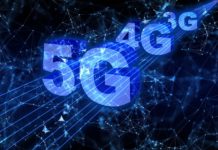In this section, we will briefly discuss some of the technological aspects on which 5G is based and we will link them to their possible impact on various fields of interest (Internet of Things, Industria4.0, smart city…)
Massive MIMO
MIMO (Multiple Input – Multiple Output) technology was born with 4G, with the aim of increasing concurrent accesses. With 5G, MIMO will further evolve becoming massive MIMO and multiplying the number of accesses.
Physically, low power antennas (ports) are multiplied and drastically reduced in dimensions to allow them to be assembled in one single station; dozens of them will be contained in a relatively small area (few dozens of cm2) and managed through extremely powerful algorithms. Massive MIMO will allow the new network to dramatically increase the spectral efficiency (that is, the number of bit that can be carried per second and frequency unit), that will go from current 10 Bps/Hz to 140 Bps/Hz. This solution will allow all the system that will need it to locally manage a huge amount of data at the same time (self-driving cars, health monitoring, industrial production…)
Beamforming
The massive MIMO is based on the use of low power microantennas. Another ad hoc technology allows to drastically reduce the required power: beamforming. Basically, highly sophisticated algorithms manage input and output signals of the antenna, making output signals directional: based on the position of receiving systems, the antenna does not emit continuously at 360°, but towards specifically required directions, taking into consideration amplitude, phase and possible disturbances.
The drastic reduction of the energy required to manage a self-driving system, thanks to this directionality, is therefore obvious. We can only imagine a massive MIMO system that has to manage phase and amplitude of signals and their directions considering that microwaves “rebound” generating disturbances and interferences: these complex algorithms shall be able to select which data to receive and to transmit and they will have to differentiate between “good” data, to be stored and used, and “bad” data, to be deleted. The number of antennas in the base stations must be optimized by taking into consideration that a larger number of them would increase transmission channels, but also interferences.
Thanks to these technologies in 2018, for the first time, Ericsson and the Japanese operator NTT DOCOMO have tested a 5G antenna installed in a car glass reaching a data transmission rate of 8.0 Gbps while travelling at 100 km/h; when the car speed was increased to 170 km/h, the download transmission rate was reduced to 3.6 Gbps.
Clearly, all of this has required an extremely sophisticated manufacturing of electronic components; nowadays, USA are still at the forefront, although China and other countries are working to gain ground and win the market.
Full-Duplex technology
This is a technology planned for 5G that allows to uninterruptedly transmit and receive data at the same time on the same frequency.
Wi-Fi systems already introduced something similar to manage multi-user services; in fact, Half-Duplex is based on the separation of the various signals in data packages, to which the router management software assigns timing so that they do not collide (Time Division Duplexing, or TDD).
Clearly, this system works fine until the number of concurrent users does not entail unacceptable queuing… and we clearly bear in mind when we wait too long for the loading of a webpage.
Getting back to 5G, the adopted solution refers to a well-known phenomenon of electromagnetic waves: polarization. In practice, electromagnetic waves vibrate on two planes, the horizontal and the vertical ones. To polarize means to add a filter that allows the passage, for instance, only of one of the two components. Without going into further details, if the input signal is vertically polarized and the output signal is horizontally polarized, they can travel through the same channel without interfering. The net result is to double the number of transmission channels. This extremely simplified concept is at the basis of the Full-Duplex technology, that has been developed as a prototype, described in the article “85–110-GHz CMOS Magnetic-Free Nonreciprocal Components for Full-Duplex Transceivers”, where the authors describe the CMOS components that are needed to obtain a 45 dB separation between two signals that travel at the same frequency.
Other devices have been developed that are able to work at lower frequencies, though not lower than 30 GHz.
D2D (Device to Device)
D2D technology is another communication modality for 5G networks. In simple terms, when two users are connected to the same cell, their device communicate among themselves by a direct connection. This brilliant idea allows to lighten the load of the network, at the price of more sophisticated management algorithms: the system must always know if the users are still in the same cell, otherwise the connection through the network must be restored.
The D2D, also known as ProSe (Proximity Service), in addition to relieve the network workload, will ensure a higher connection safety and lower latency; this generated a relevant expectation in social and commercial services, based on user localization. The shopping centers will be able to directly send advertising to the users in the same cell, while theatres and cinemas will be able to deliver information skipping the general network, not to mention the use for emergency situations in which the network structure might be damaged, in which D2D might be efficiently used by rescuers and victims to communicate with each other.
Clearly, there will be heavy repercussions on communication between vehicles: the possibility to receive information on road traffic in a specific area, accidents, vehicle organization as wagons of the same train, with a remarkable improvement in drivers’ quality of life and a significant saving of time and fuels, that is added to the saving of network load.
Smart homes too will benefit from the D2D, allowing to connect various devices and eventually to communicate data to an ultrafast network that is hard to reach.
It goes without saying that D2D technology will compete with Wi-Fi networks, based on the possibility offered by modern standards (11ax).
Network slicing
This possibility offered by 5G is certainly the evidence of the great flexibility gained with respect to previous networks, followed by the possibility to invest in other production lines savings obtained from the, first inevitable, redundancies.
The most important effects of what will be enabled by the architecture of the network will be at company level: each company will be able to choose which “slice” of the network to rely on to run the business, based on its peculiarities. The 5G network can be divided in three main categories, based on the use that a company user wants to take to practice:
- Enhanced Mobile Broadband (eMBB): when a reliable broadband connection is needed, for applications such as self-driving. This is useful for cloud services, infotainment, smart city, fleet management
- Internet of Things (IoT): reduced bandwidth but a large amount of low-power, inexpensive and non-specific connections
- Ultra-reliable low latency communication (uRLLC): highest reliability and lowest latency at the same time, then at a higher cost. In support of self-driving systems and factories of the future.
Starting from these categories, a company can choose which one better adapts to its needs, or choose multiple network slices, each of them independently managed. Nothing to do with previous networks, which were definitely monolithic.






